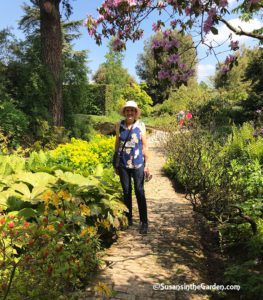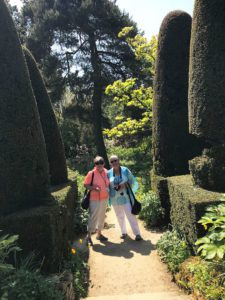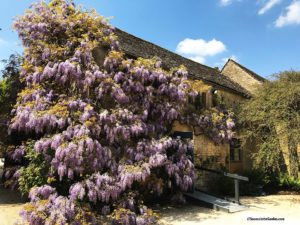Travel Stories: English Gardens Tour (5)

 (This is the fifth in a series of blog posts about the English Gardens Tour I led from May 16-27, 2018. Remember that you can click on any of the photos to view a larger image.)
(This is the fifth in a series of blog posts about the English Gardens Tour I led from May 16-27, 2018. Remember that you can click on any of the photos to view a larger image.)
On Saturday, May 19, our tour group got to explore a lovely Cotswolds village and one of my favorite gardens, Hidcote.
The Cotswolds is a delightful region in south central England that is extremely desirable to live in. I would move there in a heartbeat, I might add! It is particularly known for its charming villages lined with buildings made from the distinctive honey-colored limestone blocks. You’ll often see a lovely rose climbing up the front of a home and perhaps a nice front garden surrounded by low walls.
The village we visited was Bourton-on-the-Water (see photo above left). It is known as the “Venice of the Cotswolds” because of all of the bridges crossing the river Windrush. There is a miniature 1930s replica of the village, a model shop selling model railways, etc. Birdland houses all sorts of birds and even life-size model dinosaurs. Since we only had a little over an hour, we mostly just wandered around the village, taking photos and popping into interesting shops.
I managed to find a craft shop called “The Bourton Basket,” which carries needlework supplies, yarn, fabrics and other crafty items. Since I’m a quilter, it’s always fun to find fabrics that we can’t buy back at home so I was feeling particularly happy about my purchases.
 We soon departed for Hidcote Manor Garden which my tour group especially loved. This was my third visit to Hidcote, yet I never grow tired of exploring all it has to offer and would happily go there again.
We soon departed for Hidcote Manor Garden which my tour group especially loved. This was my third visit to Hidcote, yet I never grow tired of exploring all it has to offer and would happily go there again.
Even though it seems like a quintessential English garden, Hidcote was actually designed by an American! Major Lawrence Johnston was a wealthy horticulturalist who designed the gardens on the estate for his mother and himself in the Arts and Crafts style.
My favorite part of touring the garden is walking through all of the garden rooms, never knowing what to expect as you travel from one to the next. Each is surrounded by clipped hedges and there are so many beds overflowing with beautiful combinations of plants. There’s also an interesting vegetable garden.
 For our visit, we started out with an introductory talk by a docent, to learn more about the history and layout of gardens. Then we had 2 1/2 hours to explore them. We also took advantage of the lovely cafe for lunch and the all-important gift shop.
For our visit, we started out with an introductory talk by a docent, to learn more about the history and layout of gardens. Then we had 2 1/2 hours to explore them. We also took advantage of the lovely cafe for lunch and the all-important gift shop.
As my husband, Bill, and I came across members of our tour group, we immediately noticed the delighted smiles on their faces! Another garden winner! There are so many different areas to explore and it’s easy to get a bit lost so having a map of the garden in hand is a very good idea.
 At the far edge of the garden is a wonderful view of the surrounding countryside, as you can see. There’s also a large herd of sheep nearby, and their constant baa-ing to each other was pretty amusing.
At the far edge of the garden is a wonderful view of the surrounding countryside, as you can see. There’s also a large herd of sheep nearby, and their constant baa-ing to each other was pretty amusing.
Once again, we were blessed with a warm, sunny day and we were all happy to explore such an iconic English garden.
Here are more photos from our visit to Hidcote Manor Garden:
The unusual tree directly above is the handkerchief tree (Davidia involucrata), which we saw at many of the English gardens we visited. Hardy in USDA zones 6 to 8, the tree is so named for the white flowers hanging down, which look like “hankies.”
If you’re wondering about this last photo, they place these large clay pots over developing rhubarb stalks in order to “blanch” them, which makes the rhubarb tender and tasty.









